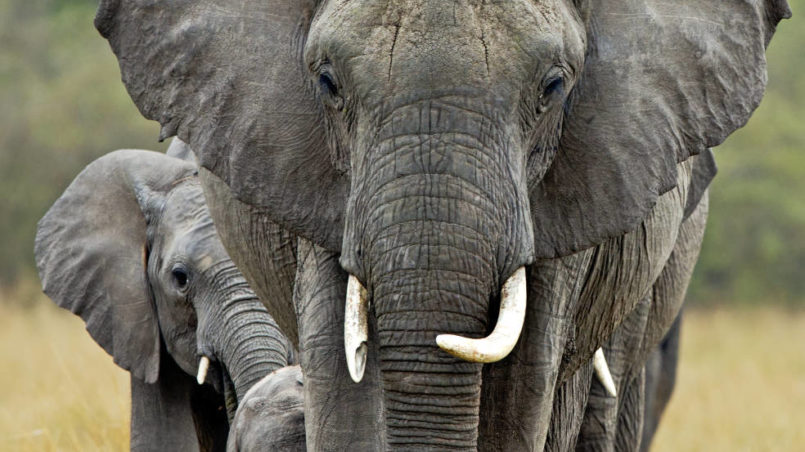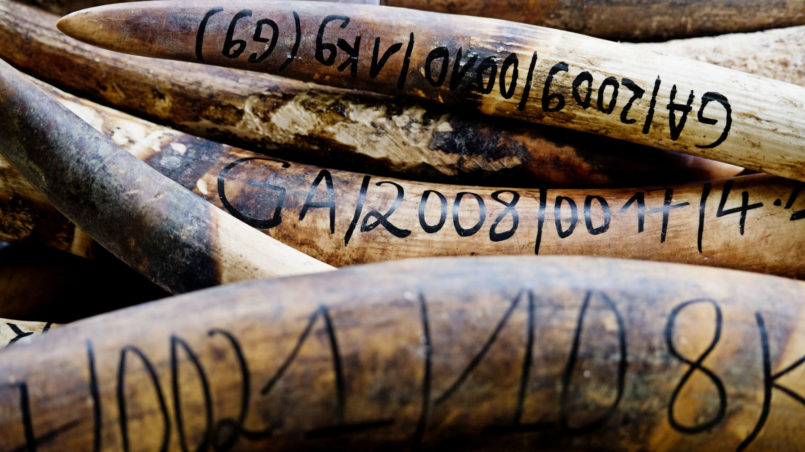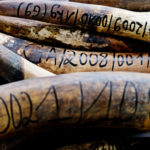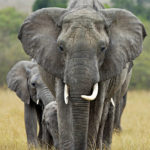Can the African Elephants’ Extinction still be prevented?

African elephants are impressive, iconic creatures. But with their tusks, they carry a material that is immensely valuable – and a strong incentive to kill them. The growing demand for ivory in Asia, in conjunction with political problems in some African countries, is fueling an escalating poaching which has brought the species to the brink of extinction within a short time. In the last few years, shocking numbers about the decline in African elephants have been made public: scientists fear that the species could be eradicated within the next twenty years!
While elephants – like many other animal species – are increasingly under pressure through the destruction of their natural habitats, the factor most threatening at present, however, is the mass shooting of the animals to get at their ivory, for ever higher prices. This problem is not new, but it seemed to have been largely solved a few years ago:

For some time it did not look all that grim for elephants. However, as early as 1997, the ban on trade was being weakened by a series of special regulations. In the USA, ivory can be imported if it is a hunting trophy, and in China it is legal to sell material from existing stock in small quantities. What had the greatest impact, however, was a special permit, which allowed some African countries to sell large quantities of seized tusks, which had been put into storage at the time of the trade ban’s implementation. As a result, very large amounts of ivory suddenly came onto the market. The big problem:
Thus the ivory trade has been able to pick up momentum again since the end of the nineties. However, poaching remained relatively low for a long time: between 1997 and 2008, only about 0.6% of the elephant population was killed annually, which was not yet a threatening number. Since the late 2000nds however, the amount of ivory traded has suddenly increased enormously, and the number of killed elephants quickly reached dimensions which are extremely dangerous for the survival of the species:
Since the number of animals killed has far exceeded the birth rate for years (elephants have a very low reproduction rate and can only increase their numbers slowly), the collapse of the populations within a few decades is unavoidable unless poaching is significantly reduced.
In the last two years, truly shocking figures have come to light about the extent of this massacre. The results of the “Great Elephant Census” were published at the end of August 2016. The immensely laborious census over the course of two years showed that the population in 18 African countries fell by 30% between 2007 and 2014 with the decline rate rapidly growing at currently around 8 % per year (for details, see www.greatelephantcensus.com and www.elephant-atlas.org). The scientist, Dune Ives, who was involved in conducting the study, pointed out at the “Elephant Summit” of Botswana in March 2015 that the elephants will be completely eradicated in ten to twenty years if things continue as they are. Poaching is, without a doubt, responsible for this development, other problems, such as climate change or the destruction of natural habitats, are far less determinant.
Ivory as a financial basis for terrorist groups
The poaching is, however, not only fueled by the constant rise of the ivory price and the still pressing poverty in much of Africa. For some years now, another, extremely threatening component has been added:
According to the WWF, it has happened before that local rebel groups were financed by elephant poaching, but the problem grew to a completely new dimension within a short time between 2005 and 2010. The Lord’s Resistance Army (LRA), in particular, plays a key role. This extremely inhumane and violent rebel group was founded in Uganda during the eighties, by Joseph Kony, who still remains their undisputed leader. The LRA have become known mainly through terrorist acts against the civilian population, including the massive enslavement of child soldiers. Today, Kony is one of the most wanted terrorists in Africa; he is currently residing in southern Sudan, where he has excellent relations with the military and high-ranking politicians.
In 2015, the American investigative journalist, Bryan Christy, in collaboration with the National Geographic Society, carried out an elaborate experiment: he had an artificial imitation of a tusk produced and fitted it with a GPS device, which constantly transmitted its position. Christy planted the imitation into the stream of the wild ivory in the Central African Republic, to understand the transport routes, which up to that point were not backed up with solid evidence. The experiment worked and proved that the LRA smuggled poached ivory – utilizing carrier columns that travel through the jungle for parts of the route – into South Sudan to exchange it for weapons. But also the Sudanese Janjaweed militia, as well as the Islamic organization, Al-Shabaab from Somalia, have discovered the ivory trade as a new source of money. Since elephants have long since ceased to exist in their countries, they undertake downright forays to neighboring states, where they kill as many animals as possible in a short time.
In this way, the ivory generates profit for unscrupulous terrorist organizations, a “conflict resource” similar to the “blood diamonds” that fueled the civil war in Sierra Leone during the 1990s.
The national parks’ rangers, who are tasked with the elephants’ protection, are much weaker in numbers than the poachers, and poorly equipped. They are confronted with a demotivating superior strength, which inflicts an all-out war on them: in January 2009, the Rangers’ headquarters in the Garamba National Park in the Democratic Republic of the Congo were attacked by a 180-strong LRA group, killing 17 rangers. Garamba is still a hotspot of elephant poaching by the LRA, which has kept the park largely under control for years and is all but clearing it out.
Where does the ivory go?
The ivory is taken from the poaching areas directly or via detours, to East African coastal countries, such as Kenya or Tanzania. In their export ports, it is hidden in containers with inconspicuous goods and thus shipped, for the most part, to Asia. The widespread corruption in export, transit and import countries facilitates this smuggling. The main trading place is Hong Kong, China being the largest target market by far. The increase in the value of the ivory on this path is enormous: African poachers currently receive about 100 US dollars per kilo, but more than twenty times this amount is paid in China!
In Europe, illicit trafficking in ivory is virtually irrelevant due to the rigorous enforcement of strict laws and widespread awareness of the species conservation problem. In East Asia, on the other hand, it is highly sought-after as “white gold” and is offered quite openly in the displays of smart shops: jewelery and artfully carved sculptures yield enormous prices, objects of ivory are regarded as high-quality status symbols as well as lucky charms. A gift made of ivory guarantees high social status to both the donor and the recipient.
Their demand is the fuel for poaching in Africa and triggers a paradoxical development: the fewer elephants there are and the scarcer the ivory thereby becomes, the higher its value rises. As a result, profits can be kept stable or even increased despite the low volume of trade.
Meanwhile, efforts are being made to curb demand in the Asian countries through information campaigns designed to change the social status of ivory. If it were possible to make the ownership of ivory objects socially unacceptable, much would be gained. However, even at the highest level, a change of views seems to be taking place in Asia. At the end of December 2016, the State Council of the People’s Republic of China announced its intention to ban ivory trade in 2017. The news attracted worldwide attention. Eberhard Brandes, CEO of WWF Deutschland, is optimistic:
China is currently the world’s largest legal ivory market. Its closure is an important prerequisite to stop the slaughter of the elephants.
It remains to be seen whether poaching can be contained by this measure to such an extent that the animal population can gradually recover; after all, this only concerns China, this country being the largest but not the only market – plus a black market could develop. It is, however, good news in any case, for its great signal effect alone, says Brandes:
If the market closes and is successfully controlled, this could be a first step towards the end of the catastrophic poaching crisis in Africa.
Related Links:
National Geographic: How Killing Elephants Finances Terror in Africa
WWF: Huge drop in African elephant population
National Geographic: U.S.-China Deal to Ban Ivory Trade Is Good News for Elephants
National Geographic: Why Shutting Down China’s Ivory Trade Won’t Be Easy
Credits
| Image | Title | Author | License |
|---|---|---|---|
 |
Ivory | James Morgan | mit freundlicher Genehmigung von WWF (Hannes Greber) |
 |
African elephants | Andy Rouse | mit freundlicher Genehmigung von WWF (Hannes Greber) |
